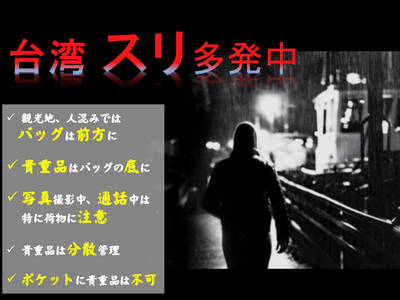Typhoon Morakot unleashed its fury on southern Taiwan last month, causing Taiwan’s worst natural disaster in a decade and forcing the evacuation of 24,950 people, while leaving 571 dead, 106 missing and 33 injured. As of yesterday, more than 2,650 people were still living in 32 shelters.
During the immediate aftermath, TV screens were filled with seemingly endless footage of flood and mudslide victims crying for help or anxiously awaiting the return of loved ones.
But while most news coverage and the public focused on the plight of residents of disaster areas, a number of groups of volunteers turned their attention to the suffering of stray animals caused by the storm.
The Central Emergency Operation Center did not release any official data about the number of stray animal fatalities during the typhoon, but preliminary estimates by Animal Rescue Team Taiwan showed that at least 1,000 stray cats and dogs were left homeless as a result of the disaster, while more than 300 were drowned or buried alive by the landslides.
Shelters run by individuals in southern Taiwan — the majority of them dilapidated makeshift buildings — suffered the most seriously.
For example, more than 100 dogs caged in a shelter under the Kaoping Bridge drowned after floodwater in the area rose to around one story deep, while dogs and cats in a number of shelters in Kaohsiung County almost died of hypothermia, the rescue team said.
International Fund for Animal Welfare volunteer Dick Green traveled to southern Taiwan with several members of the charity in response to cries for help from rescue teams. He said upon arriving at the disaster areas late last month that more dogs could die if the shelters did not receive relief supplies in time.
To coordinate donations of dog and cat food, cash and medical supplies and to maximize relief resources, the rescue team launched an online platform to help the strays, which volunteers described as “often ignored by the media and rescuers.”
The platform received up to 500,000 visits while more than NT$1 million (US$30,000) in donations poured in from around the nation within just a few days.
Ni Ching-tai (倪京台), convener of the platform, said the budget needed for reconstruction of all of the shelters in southern Taiwan could amount to several million NT dollars.
Meanwhile, volunteers at the Taiwan Life Caring and Animal Rescue Organization brought bags of food and bottles of disinfectant donated by Netizens to private stray shelters when they drove from northern Taiwan to the south last week.
This was their second visit to the disaster area since the typhoon struck.
Joined by the organization’s veterinarian, the volunteers quickly began cleaning up the dirt and mud left over by the floods as they arrived at the individual shelters.
One volunteer surnamed Hsu described the scene as “the most horrible scene in Taiwan’s animal protection history.”
The flooding not only took the lives of hundreds of strays in the shelters of southern Taiwan, it also highlighted the disadvantages of the shelters.
Many of the shelters were managed single-handedly by individual animal lovers in open spaces in suburbs and housed hundreds of strays. The animals were either caged, chained or allowed to roam free.
The shelters had had difficulty raising donations for food before the typhoon, Ni said, adding that the flooding only put the shelters in a much more unfavorable condition.
But volunteers were also left feeling helpless when they visited the animal shelters after the typhoon.
Dubbed “a forgotten world” by volunteers of the Taiwan Life Caring and Animal Rescue Organization, footage of a shelter in Rente Township (仁德) of Tainan County showed about 500 strays, including new-born puppies, standing in their own feces.
Many of the dogs were exposed to days of torrential rain during the typhoon because they were chained or caged, the organization said.
Although the owner of the Tainan shelter claimed she cared about the strays, she admitted to the organization that she only came by to feed them once every four days.
“A lot of junk was piled up on the dog cages that had become rotten after the rain. As we removed it, as many cockroaches and spiders as I’d seen in my life came out ... it was horrible,” said one volunteer as he described his participation in the organization’s relief efforts.
“When you see [the strays] suffering in front of you, you feel like donating whatever you have to the shelter, hoping that the animals would have a place called home,” said the chief executive officer of the organization, called Tiger.
The organization offered to provide several million NT dollars to help relocate the strays, but the shelter owner rejected the aid for undisclosed personal reasons, Tiger said.
Despite the bad news, there was some good news.
As the central and local governments were preoccupied with reconstruction work and village relocation in Kaohsiung and Pingtung counties, animal rights activists also began reconstruction of some of the shelters.
The Animal Rescue Team Taiwan had given priority to the reconstruction of eight shelters under the Kaoping Bridge that were expected to cost NT$300,000.
Netizens on the nation’s largest bulletin board system, PTT, also continued to raise money for food and new cages for the shelters.

GENSLER SURVEY: ‘Economic infrastructure is not enough. A city needs to inspire pride, offer moments of joy and foster a sense of belonging,’ the company said Taipei was named the city with the “highest staying power” in the world by US-based design and architecture firm Gensler. The Taiwanese capital earned the top spot among 65 cities across six continents with 64 percent of Taipei respondents in a survey of 33,000 people saying they wanted to stay in the city. Rounding out the top five were Vietnam’s Ho Chi Minh City (61 percent), Singapore (59 percent), Sydney (58 percent) and Berlin (51 percent). Sixth to 10th place went to Monterrey, Mexico; Munich, Germany; Sao Paulo, Brazil; Vancouver; and Seoul. Cities in the US were ranked separately, with Minneapolis first at

The Japan-Taiwan Exchange Association has cautioned Japanese travelers to be vigilant against pickpockets at several popular tourist spots in Taiwan, including Taipei’s night markets, the Yongkang Street area, Zhongshan MRT Station, and Jiufen (九份) in New Taipei City. The advisory, titled “Recent Development of Concerns,” was posted on the association’s Web site under its safety and emergency report section. It urges travelers to keep backpacks fully zipped and carried in front, with valuables placed at the bottom of the bag. Visitors are advised to be especially mindful of their belongings when taking photos or speaking on the phone, avoid storing wallets and

Scoot announced yesterday that starting in October, it would increase flights between Taipei and Japan’s Narita airport and Hokkaido, and between Singapore and Taipei. The low-cost airline, a subsidiary of Singapore Airlines, also said it would launch flights to Chiang Rai in Thailand, Okinawa and Tokyo’s Haneda airport between December and March next year. Flights between Singapore and Chiang Rai would begin on Jan. 1, with five flights per week operated by an Embraer E190-E2 aircraft, Scoot said. Flights between Singapore and Okinawa would begin on Dec. 15, with three flights per week operated by Airbus A320 aircraft, the airline said. Services between Singapore

ENDORSING TAIWAN: Honduran presidential candidate Nasry Afura said that Honduras was ‘100 times better off’ when it was allied with Taipei The Ministry of Foreign Affairs yesterday said it would explore the possibility of restoring diplomatic relations with Honduras based on the principle of maintaining national interests and dignity. The ministry made the remarks in response to reporters’ questions regarding an article titled: “Will Taiwan Regain a Diplomatic Ally?” published in The Diplomat on Saturday. The article said Honduras’ presidential election in November could offer Taiwan the chance to regain an ally, as multiple candidates have promoted re-establishing diplomatic relations with Taiwan. Honduras severed diplomatic ties with Taiwan in March 2023 in favor of Beijing, but since switching its diplomatic recognition,